Care
Watering
Codiaum (or Croton) is very fond of frequent and abundant watering. Watering should be done as soon as the top layer of the substrate has dried. But after a few hours, the excess water from the sump must be drained. Water suitable for irrigation must be soft - melt or rainwater, or it must be filtered or boiled.
So that the water does not sour in the substrate, the pot must be selected so that the roots completely fill it. The topsoil should be loosened as roots develop. Do not allow it to dry out for a long time, the plant will react very quickly and begin to shed its leaves.
Lighting
Loves good lighting, but is afraid of direct sunlight. Burns are formed on the leaves from direct exposure to the sun. So it is better to protect the plant from direct rays of the fabric. For location in an apartment or in another room, choose windows facing southeast or southwest. There will be insufficient lighting on the northern windows, and the succulent will quickly fade, all the beauty of its leaves will disappear. In winter, it is necessary to provide good lighting, artificial lighting is possible.
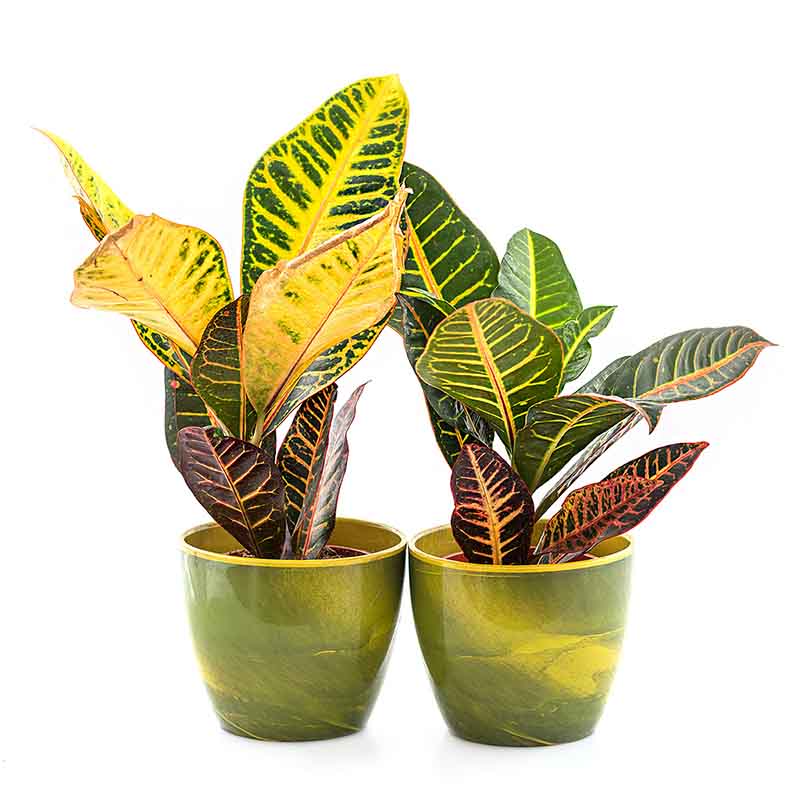
Temperature
The temperature of our standard apartments is very suitable for this plant.
- In summer, Kodiem needs 20-22 degrees of heat;
- In winter, the temperature should not drop below 18 degrees. The best location in an apartment for a succulent is close to a central heating radiator;
- Codiaum does not tolerate drafts, so you should not take it out, even on warm, windless days, to an open balcony or loggia. If an adult plant is in your winter garden, you need to make sure that no drafts touch it;
- Temperature drops are also very harmful to the plant.
Humidity
Croton is a tropical plant, therefore it needs a high concentration of moisture. You can provide the necessary moisture by daily spraying. For additional moisture, you need to place containers of water between the pots of plants. You can shower the plant once a month. If, for any reason, make an artificial rain for Codiaum, then you can wipe it with a damp sponge. This will improve the look of the plant, cleanse the pores of dust and increase moisture.

The soil
It is better to compose the substrate for the plant yourself, in store mixes for Codiaum you will rarely find a suitable one. It is not very difficult to make it. For the composition, you need to take:
- Leafy ground, preferably from under linden, birch or hazel;
- Garden humus;
- Peat (you can buy it separately at the store);
- Coarse river sand, thoroughly washed.
All components are taken in equal proportions. Add finely crushed charcoal and a little zeolite to this mixture. Then mix everything thoroughly. Charcoal is needed to suppress molds and bacteria. Zeolite absorbs fertilizers and gradually releases them, which is very beneficial for the plant.
When transplanting, all the old substrate must be removed from the roots. Damaged or starting to decay roots should be cut off and sprinkled with crushed charcoal.
Fertilizer
In order for the coloring of the leaves to remain bright, in addition to proper lighting, this plant needs mineral fertilizing. In a specialized flower shop, purchase a complex mineral fertilizer for succulents and cacti.
In the spring and summer, dilute it as written in the instructions and fertilize from spring to autumn once a week; in winter, dilute the fertilizer by half the amount indicated on the label, and apply it once a month.
Diseases and pests
Violation of the care and maintenance of the plant often leads to a deterioration in the condition of your green pets.
When the tips of the leaf plates turn brown, this may be a sign of a lack of moisture or excessively dry air.To save the plant, the irrigation regime should be changed and the green mass should be regularly sprayed. It will also not hurt to install a container with water next to it or line the bottom of the pallet with moss to maintain an optimal level of air humidification.
Leaves fall and begin to fall - this happens with frequent temperature changes, also with insufficient moisture, the presence of drafts or too low a room temperature. If the codiaum is not moved to a warm place in a timely manner and irrigation is not established, the plant can die very quickly.
The appearance of a white fluffy bloom on leaf plates - occurs when using hard tap water for watering and spraying. To restore the attractiveness of the flower, the leaf plates should be treated with acidified water, and then sprayed with the settled liquid.

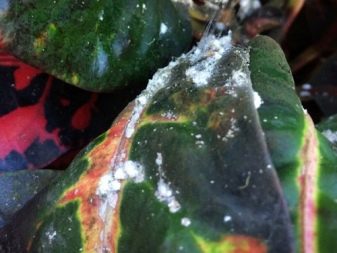
Loss of elasticity by leaves is the most common consequence of an excess of moisture, in this case, the plant should be transplanted, removing all rotten roots, and then watered only as the top layer of the earth dries up.
The leaves become faded, the stems stretch out - this is a sign of a lack of light. In this case, you need to transfer the codiaum to a more illuminated place, and if this is not possible, additional lighting will help.
The edges become thinner and brown - this clearly indicates that the plant is freezing. Make sure that the heating level in the room does not drop below +17 degrees.
Spots and blots on the leaves turn green - this directly indicates an excess of nitrogen in the top dressing.
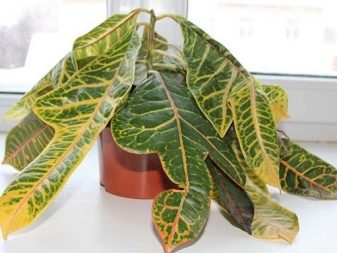
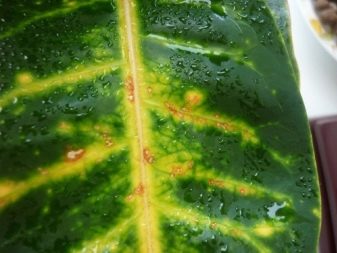
If the codiaum has lowered and shed all its leaves, the plant can still be cured and its decorative effect restored. To do this, dilute "Epin" in warm water in accordance with the instructions and spray the bush abundantly, then wrap the flower with foil and leave in a warm shaded place for 10-14 hours.
During the recovery stage, the plant needs occasional watering, since moisture evaporates very slowly in the absence of foliage. When recovery does not occur, then the condition of the root system and trunk should be checked, if they are dry, further resuscitation is pointless.
Codiaeum often falls prey to attack by insect pests. If you notice that numerous brown plaques have appeared along the veins, it means that your pet is affected by the scale insect. The pest must be removed by hand; for this, the plates and stems of the plant are wiped with a sponge dipped in a concentrated solution of laundry soap, after which they arrange a warm shower for the flower and spray with insecticides.


If the leaves began to turn yellow and wither, and a noticeable silvery cobweb appeared near the veins, there is a spider mite defeat. All diseased leaves must be removed and the crown treated with a systemic insecticide, usually Derris or Fitoverm is used. In the future, try to spray the plant as often as possible, since the mite does not tolerate high humidity.
If the plant dries quickly, the leaves droop and fall off - most likely, root rot takes place. In the early stages, it is successfully treated; for this, the plant is transplanted into new soil with the obligatory replacement of the pot. During transplantation, all damaged areas of the roots must be removed and sprinkled with crushed coal.
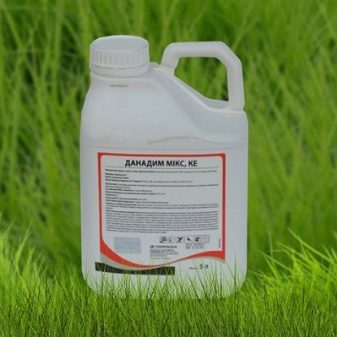
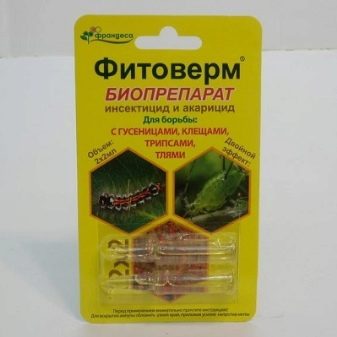
You can find out useful tips for caring for the codiaem by watching the video below.
Types and varieties of plants
In nature, there are several dozen species of croton, but only variegated croton is used for indoor cultivation. On its basis, several hybrid varieties have been bred, their photos are found in the catalogs of many stores. The most interesting varieties are the following:
Peter. The plant forms a sprawling bush with many lateral branches. Leathery foliage is located on the shoots alternately. An oval or lobed leaf blade is bright green in color with yellowish specks and stripes along the veins.
Excellence.Three-lobed, accrete leaves resemble oak leaves. Green and yellow stripes and spots are intertwined on the surface of the leaf plate. On the reverse side of the sheet, pink shades prevail.
Zanzibar. The leaves of this variety are strongly narrowed and have a compacted base. The bright green surface has yellow, orange and burgundy stripes.
Mrs. Aiston. The variety forms a small tree or a spreading bush with large leaves. On the green leaf plate, burgundy and pink spots are present, as well as golden streaks. \
Watering the plant
It should be said right away that only warm, soft and settled water is suitable for all operations with croton. Every day it is necessary to spray and wash the leaves of the plant with warm water on both sides using a soft cloth. Croton should not be grown next to appliances that exude heat: with radiators, heaters, stoves, etc., since the plant loves moisture very much, and dryness is the main cause of almost all its diseases and creates a fertile ground for the appearance of parasites.
Illumination requirements
It is very important for Croton to keep an eye on the lighting, because
it is thanks to the light that the plants acquire their unique variegated color of leaves. If the light is not monitored, and the lighting is insufficient, then the croton leaves will turn ordinary green.
The lighting mode is not the same throughout the year: in winter croton is best placed in direct sunlight, and in spring, direct exposure to them should be avoided by exposing the plant to the East or West, that is, to soft sunlight.
Temperature requirements
The upper temperature threshold is 26 degrees, and the lower 17, the optimal temperature for croton is 20-22 degrees Celsius, it should be kept the same throughout the year.
It should be remembered that dry air harms croton, it loves moisture, so it will be advisable to use a humidifier.
Fertilizer and feeding for croton
Young crotons should be regularly transplanted into fertile soil, and the soil itself should be fertilized regularly during the growing period of the plant. For this, various complex or mineral fertilizers for decorative deciduous plants are suitable, they should be applied to the soil only after watering.
Fertile land should match the soil in which crotons grow in the tropical wild. A substrate for planting or transplanting a plant can be prepared at home, for this you need to add to the soil in equal proportions:
- Peat,
- Humus,
- Sifted sand
- Sod land.
In order to prevent harmful microorganisms that cause diseases and pest larvae from remaining in the soil, it is necessary to freeze it or ignite it. If you add mute pieces of charcoal to it, this will prevent rotting of the root system.
Indoor flower codiaum variegated or croton
Variegated codiaeum, or croton (Codiaeum variegatum var.pictum) is an evergreen shrub up to 1.5 m high with large (about 30 cm long), leathery, shiny leaves of various shapes - narrow or wide, laurel or ribbon-like, spiral-twisted or bizarre - cut out.
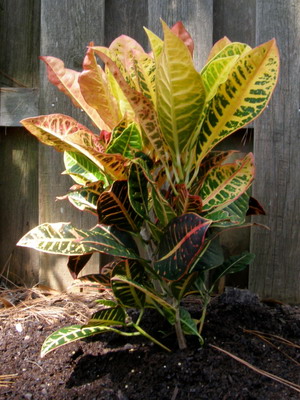
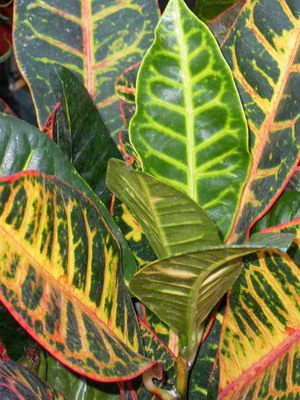
Young leaves of the indoor flower codiaum, located in the upper part of the bush, are green or slightly yellowish, but as they mature, their variegated multi-colored color appears: yellow, red, orange, brown, located in spots or along the veins. In some varieties, such an intricate pattern can be traced on the leaves that one gets the impression that an artist painted it.
Croton very rarely blooms in indoor conditions, and if it does bloom, it is better to cut off the flowers, since they greatly weaken the plant, and do not differ in special beauty. Croton flower is strewn with small white-yellow balls with fluffy stamens, collected in loose racemose inflorescences.
Reproduction methods
Growing from seeds
When growing croton in room conditions, seeds are used for its reproduction, but only if we are talking about hybrids. For sowing, it is necessary to use only freshly harvested seed material, the fact is that it loses its germination very quickly. If you decide to use this method of propagating such a plant, then you must remember that the process of growing croton from seeds is very long and that the grown plants, as a rule, will not be able to maintain varietal characteristics.
The seeds of such a flower are quite large. They need pre-sowing preparation, for this they are kept in hot water for 30 minutes (about 60 degrees), and then left for 24 hours to swell. The seeds should be deepened into the substrate by 10 mm; after sowing, the container is removed to a warm place (about 22 degrees). Until the first seedlings appear, the substrate in the container should be moistened exclusively with bottom watering. After the third leaf plate is formed at the seedlings, they should be cut into individual pots, reaching 70 mm in diameter. You need to take care of seedlings in the same way as for adult bushes.
Propagation by cuttings
This flower can be propagated by cuttings. The apical cutting takes root the easiest and fastest way, the length of which should be from 60 to 100 mm. In the case when you need to get several cuttings at once, the shoot is divided into several parts, while taking into account that each resulting cut should have one healthy leaf plate, as well as at least one internode. Semi-lignified or lignified cuttings give roots most quickly. Places of cuts must be rinsed with running water in order to remove from them the emitted milky juice, which is poisonous. After that, the cuttings are left for 3 hours in the open air, during which time the places of the cuts will have time to dry out.
At the apical cutting in its upper part, the leaf plates must be shortened in half parallel to the veins, while all the foliage should be cut off from its lower part. The lower cut is treated with Kornevin, after which it is placed in a vessel with water, which must be heated up to 23-30 degrees all the time (to prevent the development of rot). The container with the handle is removed under a bright diffused light and wait until its roots grow. After the length of the regrown roots is 20 mm, the plant must be planted in a new pot filled with soil mixture for croton (see above). After planting the cuttings, during the first decade near the bush, it is necessary to maintain an increased air humidity, for this, the plant is often moistened from a spray bottle. When the cuttings are accepted, their leaf plates will restore turgor.
HOW TO DROP CROTON BY SHARNS. 100% way.
Transfer
If Croton feels fine, then he can successfully stay in one flower pot for 2-3 years in a row. During this time, the root system grows so much that it becomes cramped in its pot. Sometimes the volume of the roots exceeds the amount of the substrate.
Despite constant feeding, the soil in the pot is severely depleted and compacted. Stagnation of water and moisture occurs, from which the roots can rot.
Most often, Kodiem just needs to increase his living space, this is called transshipment. When a plant with an intact ball is moved to a larger pot. The new container should not be too large. Otherwise, Croton will throw all his strength into growing the root system to the detriment of leaf beauty. It is optimal if the diameter of the next pot is 5-7 cm larger than the previous one.
The voids between the lump and the walls of the pot are filled with fresh universal substrate.
It is better to transplant during the period of active growth of Croton - from mid-spring to early summer.


